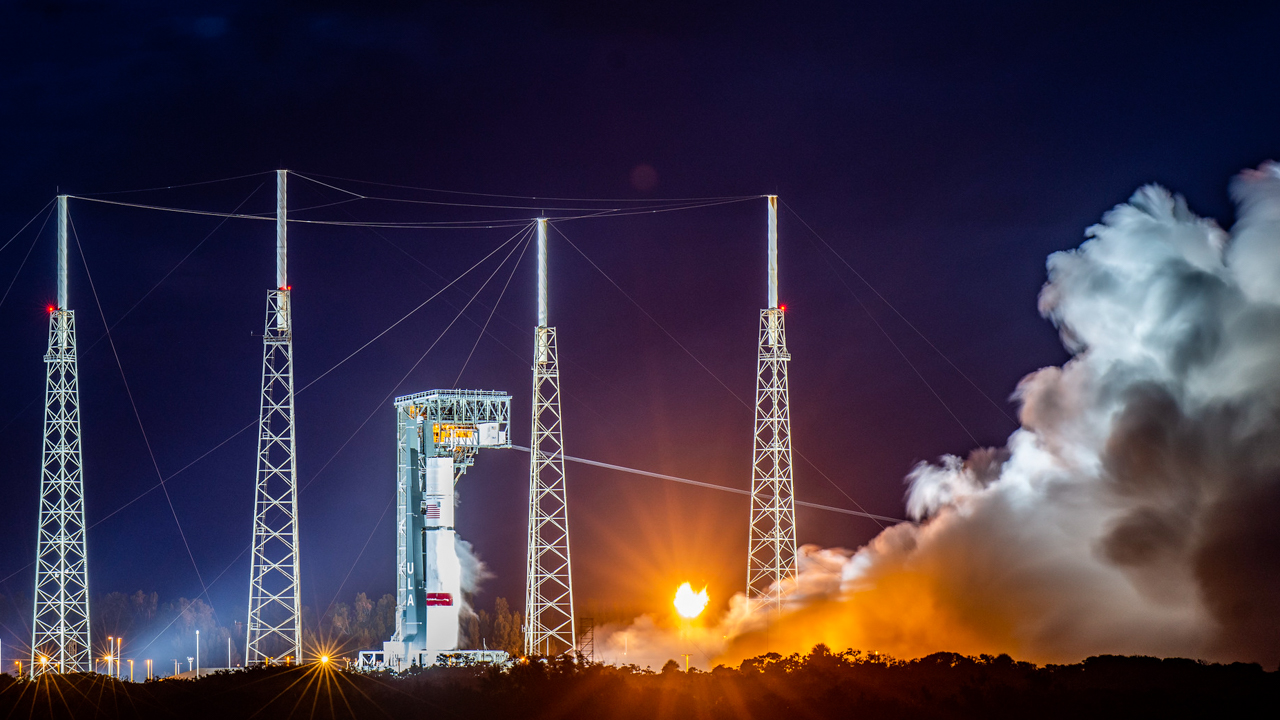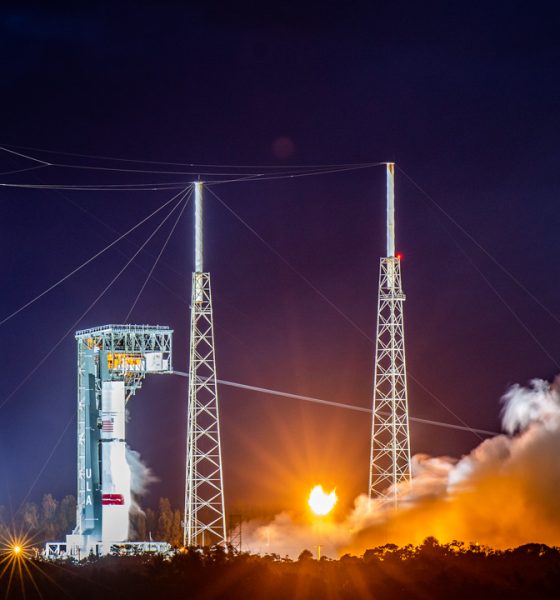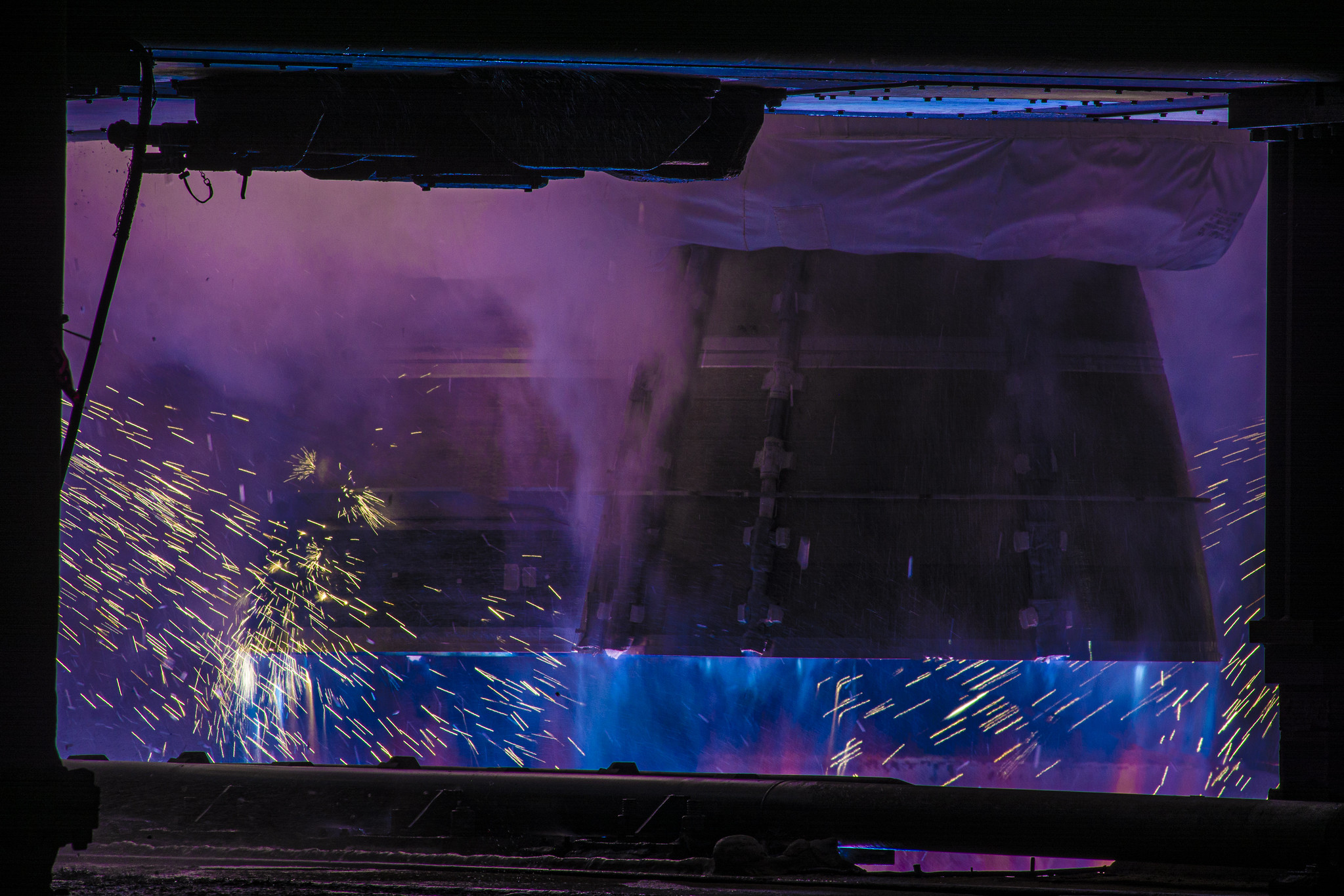

News
United Launch Alliance successfully test fires new Vulcan rocket
United Launch Alliance successfully test-fires new Vulcan rocket
Following a successful Flight Tanking Test (FTT), United Launch Alliance fired up the Vulcan rocket for the first time last night. The two Blue Origin-built BE-4 rocket engines ignited for 6 seconds and pushed ULA closer to their maiden launch of the rocket.
United Launch Alliance stated they are more than 98 percent through the qualification program for Vulcan, and after reviewing data from the Flight Readiness Firing (FRF) and closing the Centaur V anomaly investigation, they will then announce launch plans.
Ignition of the Blue Origin built BE-4 engines (Credit United Launch Alliance)
During this test firing, the BE-4 engines ignited at T- 4.88 seconds and ramped up to 60% power for 2 seconds before powering down.
The United Launch Alliance Vulcan Centaur rocket has faced many delays leading up to this moment, most recently experiencing an anomaly of the Centaur V upper stage that was undergoing qualification testing at the Marshall Space Flight Center in Alabama.
ULA is currently conducting an investigation into the cause of the anomaly, and according to ULA CEO Tory Bruno, they found the issue was on the Centaur upper stage itself, but they are still determining if changes will need to be made to its current flight article that is stacked on Vulcan.
? Let’s relive that beautiful #VulcanRocket Flight Readiness Firing! #CountdowntoVulcan ? pic.twitter.com/WqPe3jbpiW
— ULA (@ulalaunch) June 8, 2023
Prior to this unexpected issue, Blue Origin originally had planned to deliver two of their flight-ready BE-4 engines to ULA for integration onto the Vulcan rocket by 2020, but various delays in qualifications and testing meant their delivery slipped significantly to late 2022.
Following their integration onto the Vulcan rocket’s first stage, it was then shipped aboard ULA’s ‘RocketShip’ down the Mississippi River, through the Gulf of Mexico, and after rounding the southern tip of Florida to Port Canaveral, Florida, after which it was unloaded and then transported to the Vertical Integration Facility at Cape Canaveral Space Force Station.

Vulcan stands at SLC-40 prior to its Flight Readiness Firing (Credit United Launch Alliance)
This FRF test comes before the planned Summer launch of Vulcan Centaur carrying Astrobotics Peregrine Lunar lander and Amazon’s first two Kuiper satellites, their answer to the SpaceX Starlink satellite constellation.
Also known as the CERT-1 flight, the Vulcan Centaur rocket needs to perform 2 successful launches to qualify to launch national security payloads for the U.S. Space Force and other government payloads.
The second flight will feature the first launch of the Sierra Space Dream Chaser space plane, which will deliver supplies to the International Space Station. As of now, the majority of the payload manifest for Vulcan Centaur is Amazon’s Kuiper satellite constellation and U.S. Space Force national security missions.
The Vulcan Centaur rocket has a few configurations available to suit multiple payload sizes, the rocket can fly with just the 2 BE-4 engines delivering 1.1 million pounds of thrust at sea level to flying with 2, 4, or 6 solid rocket boosters and with 6 SRB’s it would bring its thrust up to 3.8 million pounds.
This would make the Vulcan Centaur capable of delivering 60,000 lbs (27,200 kg) to low Earth orbit or 25,400 lbs (11,500 kg) to the Moon. ULA is also working toward its SMART re-use system, which will allow the 2 BE-4 engines to separate from the first stage, and after an inflatable heatshield deploys, they would return to Earth and splash down for recovery and refurb for their next mission.
However, it is unknown when ULA will begin using this capability.
Questions or comments? Shoot me an email @ rangle1555@gmail.com, or Tweet me @RDAnglePhoto.

News
Tesla starts showing how FSD will change lives in Europe
Local officials tested the system on narrow country roads and were impressed by FSD’s smooth, human-like driving, with some calling the service a game-changer for everyday life in areas that are far from urban centers.

Tesla has launched Europe’s first public shuttle service using Full Self-Driving (Supervised) in the rural Eifelkreis Bitburg-Prüm region of Germany, demonstrating how the technology can restore independence and mobility for people who struggle with limited transport options.
Local officials tested the system on narrow country roads and were impressed by FSD’s smooth, human-like driving, with some calling the service a game-changer for everyday life in areas that are far from urban centers.
Officials see real impact on rural residents
Arzfeld Mayor Johannes Kuhl and District Administrator Andreas Kruppert personally tested the Tesla shuttle service. This allowed them to see just how well FSD navigated winding lanes and rural roads confidently. Kruppert said, “Autonomous driving sounds like science fiction to many, but we simply see here that it works totally well in rural regions too.” Kuhl, for his part, also noted that FSD “feels like a very experienced driver.”
The pilot complements the area’s “Citizen Bus” program, which provides on-demand rides for elderly residents who can no longer drive themselves. Tesla Europe shared a video of a demonstration of the service, highlighting how FSD gives people their freedom back, even in places where public transport is not as prevalent.
What the Ministry for Economic Affairs and Transport says
Rhineland-Palatinate’s Minister Daniela Schmitt supported the project, praising the collaboration that made this “first of its kind in Europe” possible. As per the ministry, the rural rollout for the service shows FSD’s potential beyond major cities, and it delivers tangible benefits like grocery runs, doctor visits, and social connections for isolated residents.
“Reliable and flexible mobility is especially vital in rural areas. With the launch of a shuttle service using self-driving vehicles (FSD supervised) by Tesla in the Eifelkreis Bitburg-Prüm, an innovative pilot project is now getting underway that complements local community bus services. It is the first project of its kind in Europe.
“The result is a real gain for rural mobility: greater accessibility, more flexibility and tangible benefits for everyday life. A strong signal for innovation, cooperation and future-oriented mobility beyond urban centers,” the ministry wrote in a LinkedIn post.
News
Tesla China quietly posts Robotaxi-related job listing
Tesla China is currently seeking a Low Voltage Electrical Engineer to work on circuit board design for the company’s autonomous vehicles.

Tesla has posted a new job listing in Shanghai explicitly tied to its Robotaxi program, fueling speculation that the company is preparing to launch its dedicated autonomous ride-hailing service in China.
As noted in the listing, Tesla China is currently seeking a Low Voltage Electrical Engineer to work on circuit board design for the company’s autonomous vehicles.
Robotaxi-specific role
The listing, which was shared on social media platform X by industry watcher @tslaming, suggested that Tesla China is looking to fill the role urgently. The job listing itself specifically mentions that the person hired for the role will be working on the Low Voltage Hardware team, which would design the circuit boards that would serve as the nervous system of the Robotaxi.
Key tasks for the role, as indicated in the job listing, include collaboration with PCB layout, firmware, mechanical, program management, and validation teams, among other responsibilities. The role is based in Shanghai.
China Robotaxi launch
China represents a massive potential market for robotaxis, with its dense urban centers and supportive policies in select cities. Tesla has limited permission to roll out FSD in the country, though despite this, its vehicles have been hailed as among the best in the market when it comes to autonomous features. So far, at least, it appears that China supports Tesla’s FSD and Robotaxi rollout.
This was hinted at in November, when Tesla brought the Cybercab to the 8th China International Import Expo (CIIE) in Shanghai, marking the first time that the autonomous two-seater was brought to the Asia-Pacific region. The vehicle, despite not having a release date in China, received a significant amount of interest among the event’s attendees.
Elon Musk
Elon Musk and Tesla AI Director share insights after empty driver seat Robotaxi rides
The executives’ unoccupied tests hint at the rapid progress of Tesla’s unsupervised Robotaxi efforts.

Tesla CEO Elon Musk and AI Director Ashok Elluswamy celebrated Christmas Eve by sharing personal experiences with Robotaxi vehicles that had no safety monitor or occupant in the driver’s seat. Musk described the system’s “perfect driving” around Austin, while Elluswamy posted video from the back seat, calling it “an amazing experience.”
The executives’ unoccupied tests hint at the rapid progress of Tesla’s unsupervised Robotaxi efforts.
Elon and Ashok’s firsthand Robotaxi insights
Prior to Musk and the Tesla AI Director’s posts, sightings of unmanned Teslas navigating public roads were widely shared on social media. One such vehicle was spotted in Austin, Texas, which Elon Musk acknowleged by stating that “Testing is underway with no occupants in the car.”
Based on his Christmas Eve post, Musk seemed to have tested an unmanned Tesla himself. “A Tesla with no safety monitor in the car and me sitting in the passenger seat took me all around Austin on Sunday with perfect driving,” Musk wrote in his post.
Elluswamy responded with a 2-minute video showing himself in the rear of an unmanned Tesla. The video featured the vehicle’s empty front seats, as well as its smooth handling through real-world traffic. He captioned his video with the words, “It’s an amazing experience!”
Towards Unsupervised operations
During an xAI Hackathon earlier this month, Elon Musk mentioned that Tesla owed be removing Safety Monitors from its Robotaxis in Austin in just three weeks. “Unsupervised is pretty much solved at this point. So there will be Tesla Robotaxis operating in Austin with no one in them. Not even anyone in the passenger seat in about three weeks,” he said. Musk echoed similar estimates at the 2025 Annual Shareholder Meeting and the Q3 2025 earnings call.
Considering the insights that were posted Musk and Elluswamy, it does appear that Tesla is working hard towards operating its Robotaxis with no safety monitors. This is quite impressive considering that the service was launched just earlier this year.








